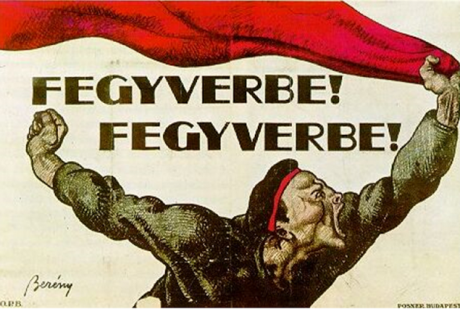Arts
You are here
What do Bartók, Lugosi, and Kun have in common?

May 27, 2020
Review of Painting the Town Red: Politics and the Arts During the 1919 Hungarian Soviet Republic
by Bob Dent, Pluto Press, 2018
Bartók, Lugosi, and Kun were all Hungarians and shared the same first name, and they were also all involved in the short lived workers' republic in Hungary in 1919.
On March 20 1919, Béla Kun and the other leaders of the Hungarian Communist party were in jail, on March 21 they were released to join the government of the newly formed Republic of Councils in Hungary and by early August they were in hiding or in exile after the workers’ republic fell and was replaced by a right-wing dictatorship.
At the end of the first world war, monarchies were overthrown across Europe and many nations were struggling for recognition. This was especially true in the Austro-Hungarian Empire which in addition to Austria and Hungary included parts of what are now five other nations. The empire quickly fell apart and revolutionary governments declared themselves in many places. In Hungary a progressive government took power in the October 1918 Chrysanthemum revolution.
This coalition of social democrats and liberals voluntarily abdicated in March 1919. The socialist party agreed to adopt the program of the Communist party and asked the imprisoned Communists to join them in government.
This was the second successful revolution based on workers councils (or soviets) after the Russian Revolution of 1917.
Painting the Town Red, is history of the arts and artists that were active during the 133 days of the council republic. Despite protestations of neutrality, most academic writing on revolutions tends to be from the right. Bob Dent has produced a fairly balanced account of the Council republic. He explores the enthusiasm for the revolution and also the criticisms that artists and prominent members of the government had at the time and in hindsight.
It’s fascinating to read about how the arts flourished during those few brief months. Most artistic endeavours were run by a “Directory,” elected in hastily called meetings in the first few days of the revolution. Some of the prominent artists elected to positions of leadership were not even present at the initial meetings.
Writers were encouraged to register with the government in order to receive support. Visual and performance artists literally painted the town red in the enormous celebrations of May Day in Budapest.
Through out the republic visual artists produced hundreds of propaganda posters promoting the gains of the revolutions and recruiting for the Red Army. Just like the young worker’s republic in Russia, the republic of councils was faced by invasion supported by the victors of World War I.
Even the young film industry was organized democratically and produced films for the revolution. Plans were made, but never fulfilled, to build children’s theatres thought the major cities. You can watch films of this period online. Jön az öcsém (My Brother is Coming, with English subtitles) directed by Michael Curtiz who would go on to direct Casablanca. If you search for Vörös Riport Film (Red Newsreel) on YouTube, you can watch all 20 editions that were produced. Dent points out the unintentional poignancy of the last scene of the final newsreel: children building sandcastles.
The discussion of censorship is tremendously interesting. Some works and articles critical of the regime were published and some were censored. In some cases editors were changed by the government, or publications were shut down. The government used the very real paper shortage to deny paper to papers and magazines that were deemed to be counter revolutionary. In a country being invaded by its neighbours who were backed by victors of the First World War how could it be otherwise?
Of course, the combined might of the world’s capitalists states did prevail. Losses by the Red Army, a land policy that angered landless peasants, the endless shortages in a besieged country at the end of the First World War, and differences between the Communists and Social Democrats overwhelmed the council republic. On August 1st the Budapest Worker’s council voted to form a new government of only members of the Social Democratic party. Within days this was overthrown; a right wing dictatorship would remain in power until 1944.
Section:
Topics:










